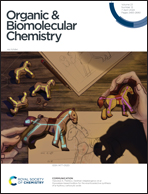Electro-oxidative intermolecular CSP2–H amination of heteroarenes via proton-coupled electron transfer†
Abstract
A new electrochemical proton-coupled electron transfer method for the intermolecular CSP2–H amination of heteroarenes without oxidants, metal catalysts and external electrolytes has been developed. Various new N-containing heteroarenes were prepared in medium to high yields, and the indole-containing product could be converted into practical 2-oxindole by simple basic hydrolysis. Mechanistic investigation indicated that ester sulfonyl-substituted N-radicals could be formed by the combination of 2,6-lutidine and electrochemical oxidation, which is the key to achieve the desired chemoselectivity.



 Please wait while we load your content...
Please wait while we load your content...